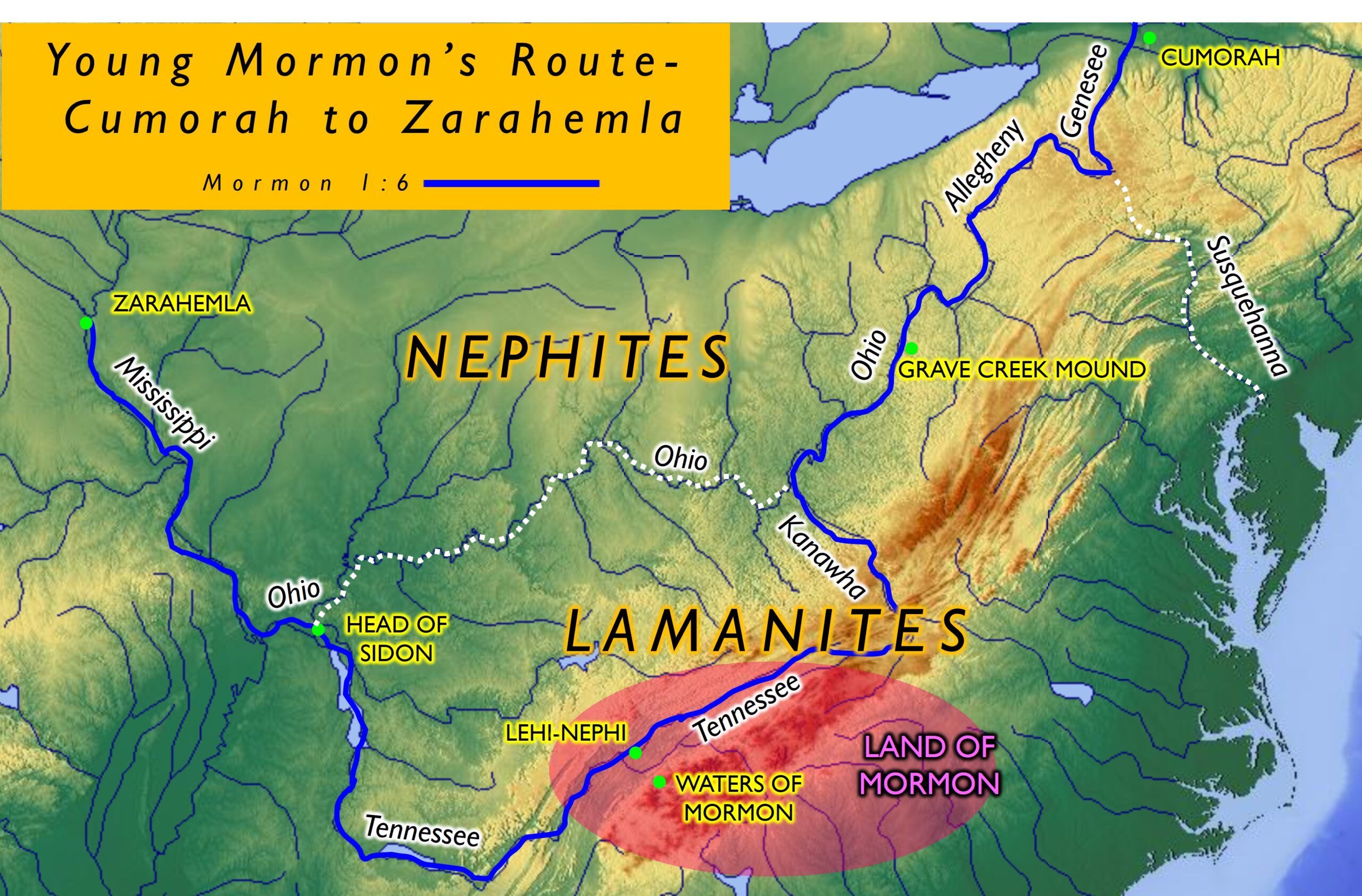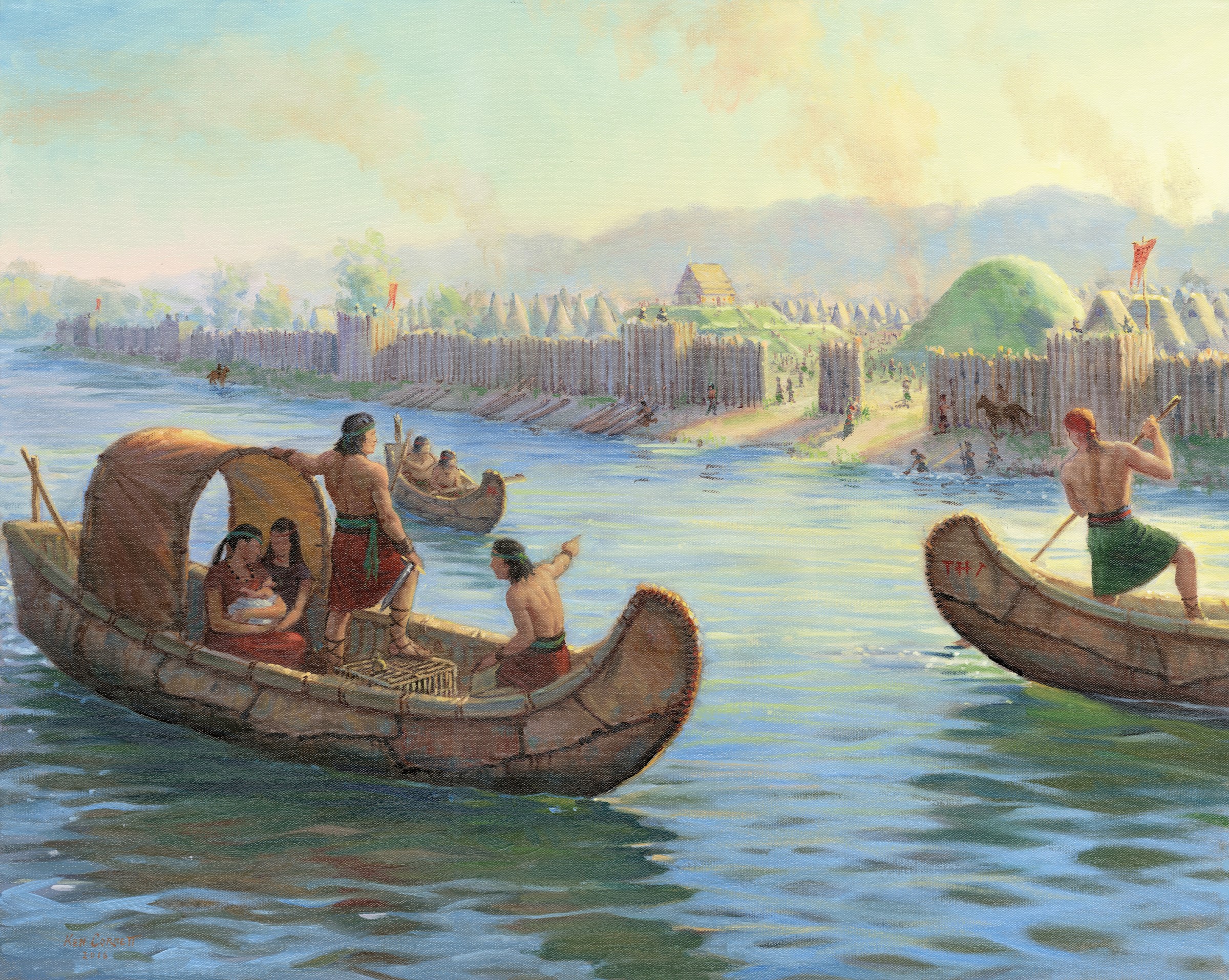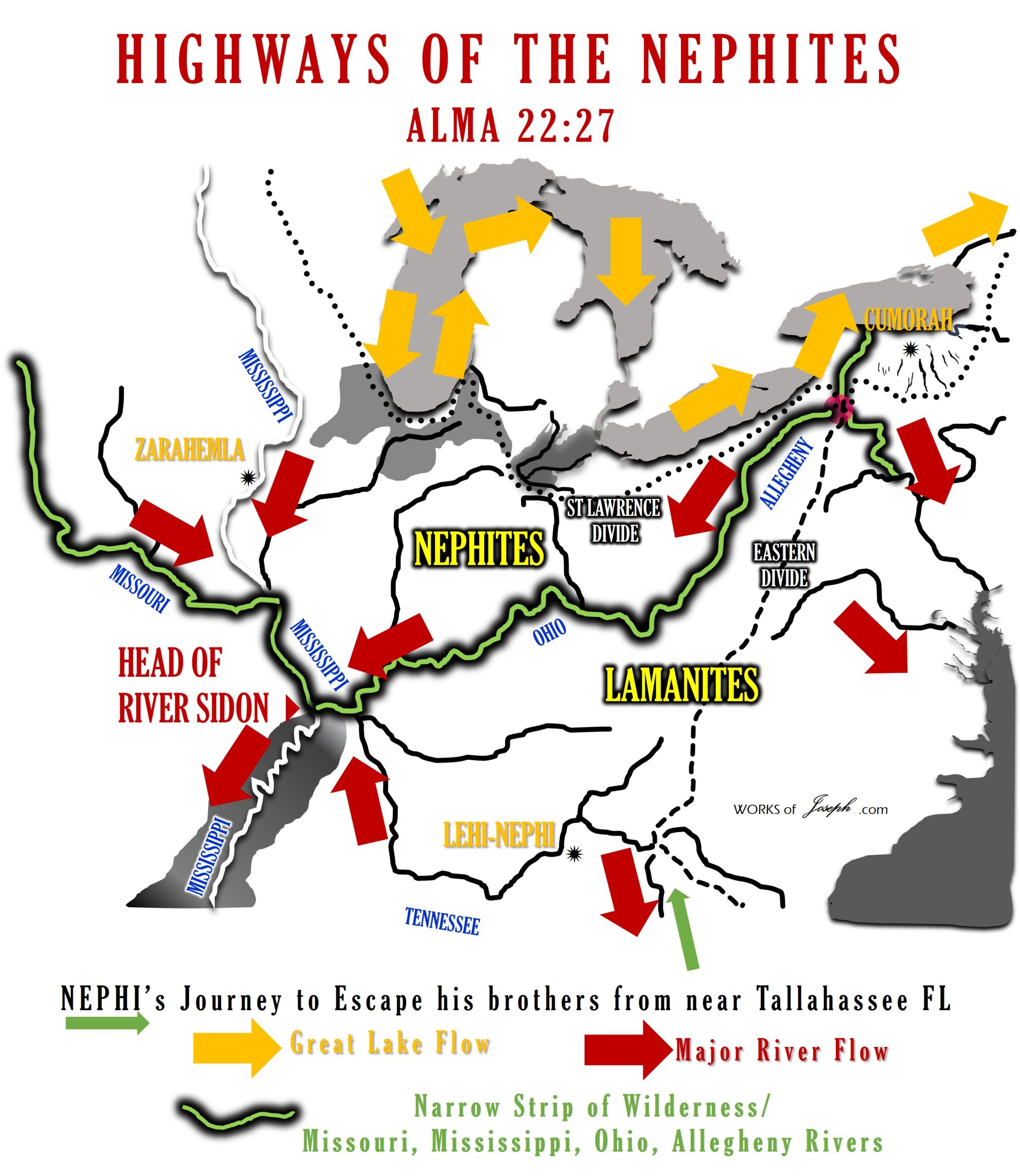Rivers in North America were the Highways of the Nephites
Jonathan Neville said, “From the perspective of people who used water as boundaries and highways for travel, it would be significant that these lands, [the lands of the Nephites and the Lamanites]—both of them—were “nearly surrounded by water.” The border between them had to be water. In fact, this requirement reinforces the conclusion that the narrow strip of wilderness was a water border.
The land of Nephi is defined by water borders, starting at the northeast with the narrow strip of wilderness. This is the Allegheny down to the Ohio, then south on the lower Mississippi (Sea West) to the Gulf Coast, east to the Atlantic Ocean, and north to one of the river systems flowing out of western New York, such as the Susquehanna River or the Mohawk and Hudson Rivers. This leaves a gap—a small neck—in western New York by the Pennsylvania border in the area of the triple divide, where two continental divides meet. This area is about 80 miles south of the Hill Cumorah and is the location of the headwaters of three rivers that can take a traveler to the Chesapeake Bay, the Gulf of Mexico, or the Gulf of St. Lawrence.
The land of Zarahemla was also nearly surrounded by water. Starting at the gap, or small neck, in western New York and moving southwest, the land is bordered by the Allegheny River, the Ohio River, the upper Mississippi River, and the Missouri River to the wilderness in the northwest. The rivers and lakes of Minnesota and Wisconsin border the north. Moving east are the Great Lakes, all the way back to the gap or small neck.” Moroni’s America page 57
Bark Canoes
“Canoes were developed over the course of thousands of years by the native peoples of North America. The word ‘canoe’ originated from the word ‘kenu’ – meaning dugout. North American Indians are responsible for creating the more well-known version of the canoe – a frame of wooden ribs covered with the lightweight bark of birch trees, and sometimes elm or cedar trees. These boats, which have remained virtually unchanged in design for thousands of years, proved to be ideal for travelling the numerous streams, rivers and lakes of North America. Birch bark was the perfect choice to build canoes because, not only was it lightweight and smooth, but it was also waterproof and resilient. The joints of the canoes were held together by the root of the white pine and then made waterproof by applying hot pine or spruce resin…
Many of the canoes that fur traders used were capable of carrying a crew of up to 12 people and a cargo weighing around 2400 kilograms… At a typical length of 14 ft. and weight of 50 lbs., the canoes were light enough to be portaged, yet could carry a lot of cargo, even in shallow water. Although susceptible to damage from rocks, they are easily repaired.” Bark Canoes Canadian Museum of Civilization.
Young Mormon Travels from Hill Shim to Zarahemla
The map above depicts a possible route that Mormon and his son Mormon may have traveled in a Nephite type canoe. They began in the Cumorah area as we know from scripture they were near the hill Shim. (See Mormon 1:3). We also know the Land of Mormon was named after Mormon (See Mosiah 18:4), and would most generally be located as indicated on the map near the Waters of Mormon, which we have said is very plausible to be near the City Nephi near Chattanooga, Tennessee. (Blog Here)
The painting below is depicting Mormon with his son Mormon and his possible other family members in Mormon 1:6-7 that says, “And it came to pass that I, being eleven years old, was carried by my father into the land southward, even to the land of Zarahemla. The whole face of the land had become covered with buildings, and the people were as numerous almost, as it were the sand of the sea.”
Mormon was traveling to Zarahemla as we know that by reading Mormon 6:10 it says, “And it came to pass that the war began to be among them in the borders of Zarahemla, by the waters of Sidon.” That means they would have been near the Mississippi River and Montrose, Iowa where we believe the City of Zarahemla was located. (See D&C 125:3)
Shown in the map and painting as a possible tour of the Land Mormon as he shows his son and family where he grew up, as they may have traveled down the Ohio River near Moundsville, West Virginia. You see the Cave Creek Mound depicted and the crowded village of people. During this journey by canoe it is very likely that young Mormon would have kept a type of journal probably on parchment or papyrus as you imagine in this painting. This way he could recall what to write at age 24 as Ammaron had commanded young Mormon to keep a record.
It also seems likely that Mormon would have brought with him the Sword of Laban and breastplate and others would have their armor, such as head plates, and weapons nearby. They may have even used the Liahona, or other devices for physical and spiritual guidance as well.
This art by Ken Corbett above, seems like a great representation of the Nephites traveling in canoes, as I believe the rivers in North America were the highways of the Nephites. As you read below about this amazing discovery of a canoe in Wisconsin, it brings the lives of the Jaredites and Nephites closer to each of us. I thank my cousin Vicki Darais for sharing this article with me.
A second ancient canoe is found in Wisconsin — this time tracing back to 1000 B.C.

Tamara Thomsen was giving a scuba diving lesson in Wisconsin’s Lake Mendota when she noticed a piece of wood peeking out of the sand. Her student didn’t think much of it but Thomsen, who is a maritime archaeologist by trade, knew exactly what it was.
“This is not a joke. I found another dugout canoe,” she texted her boss.
The boat discovered in May was the second artifact Thomsen accidentally stumbled upon within the past year. In November 2021, Thomsen spotted a 1,200-year-old canoe while swimming in the same lake during her day off.
Archaeologists from the Wisconsin Historical Society — where Thomsen works — determined that the most recent find is even older — about 3,000 years old, the group announced on Thursday.
Thomsen said that when the radiocarbon dating results from came back, she wrote “1000 B.C.” on a Post-it note and stared in disbelief.
“It just makes you think about the people that were on this landscape where I live, and to imagine they were here hunting, gathering, fishing” she told NPR.
The canoe is about 14.5 feet long and carved from a single piece of white oak. It is believed to be the oldest canoe discovered in the Great Lakes region by roughly 1,000 years.
The two boats were located about 100 yards apart. Experts said the location and close proximity of the boats suggest that ancient villages may have once existed where Lake Mendota is located and the shoreline may have shifted over time.

The 3,000-year-old canoe is believed to be the earliest direct evidence of water transportation used by native tribes from the Great Lakes region.
Members from the Ho-Chunk Nation and Bad River Tribe joined the Wisconsin Historical Society to recover the canoe last spring.
“The recovery of this canoe built by our ancestors gives further physical proof that Native people have occupied Teejop (Four Lakes) for millennia, that our ancestral lands are here and we had a developed society of transportation, trade and commerce,” Marlon WhiteEagle, the president of Ho-Chunk tribe, said in a statement on Thursday.
Both boats discovered by Thomsen will undergo a two-year preservation process.
Thomsen said archaeologists are planning to work with the Ho-Chunk Nation to conduct the first systemic search in Lake Mendota and possibly discover more canoes this coming winter. https://www.mprnews.org/story/2022/09/24/npr-3000-year-old-canoe-found-wisconsin






